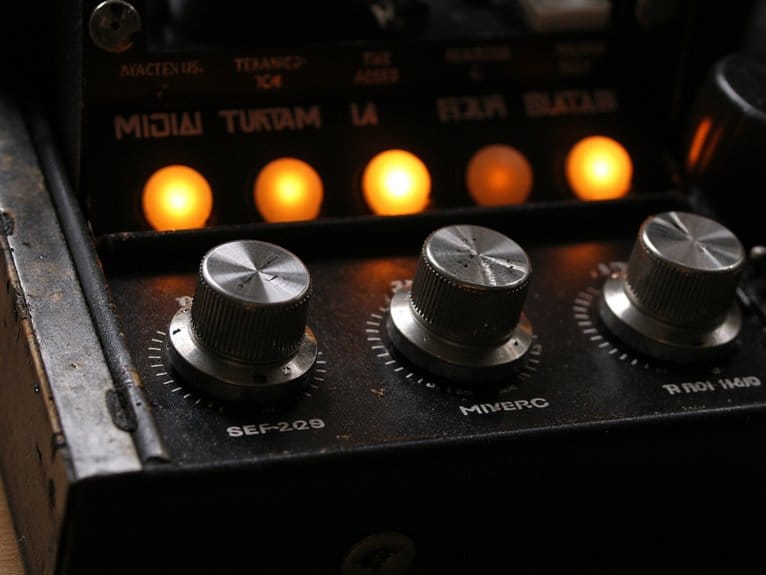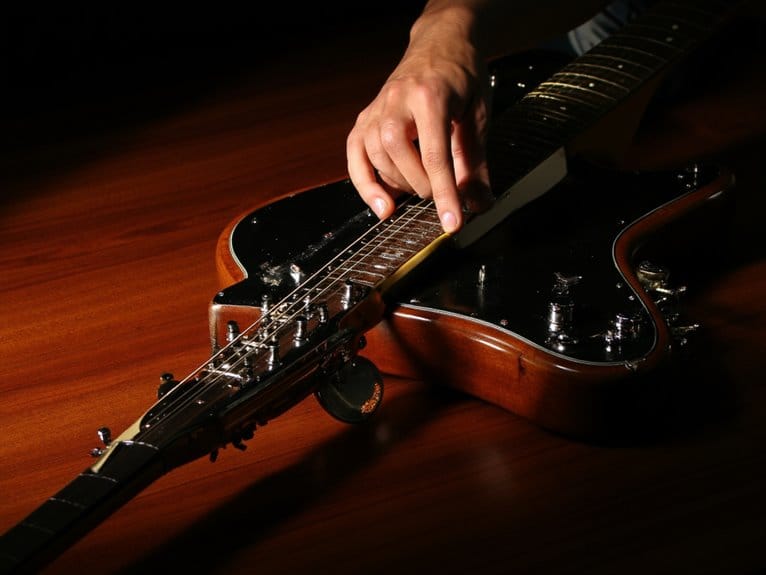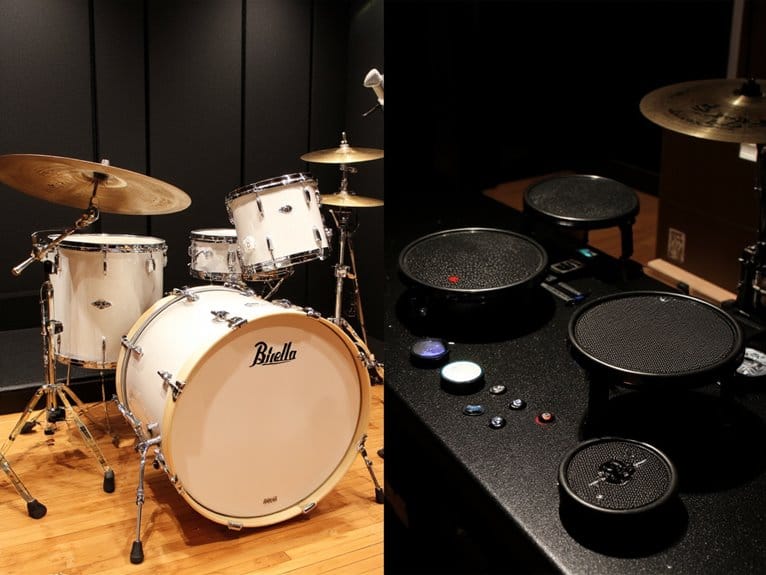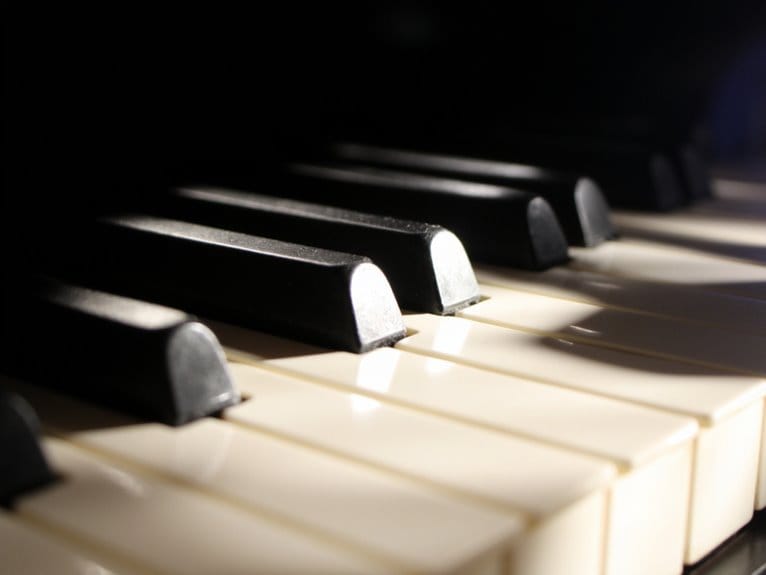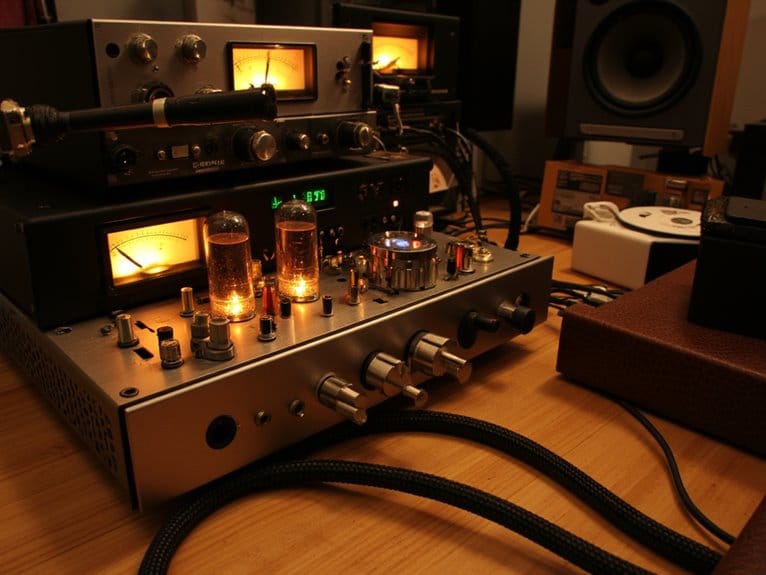Understanding Synthesizer Envelopes: ADSR and Beyond
ADSR envelopes transform your synthesizer’s static waveforms into dynamic, expressive sounds by controlling four essential stages: Attack determines how quickly sound reaches peak volume, Decay sets the drop to Sustain level, Sustain maintains consistent amplitude while you hold keys, and Release controls fade-out timing after key release. You’ll shape everything from punchy percussion with fast attacks to cinematic swells using slow filter cutoff modulation, while extended envelope types like AHDSR and multi-stage variations open up even more sophisticated sound design possibilities ahead.
We are supported by our audience. When you purchase through links on our site, we may earn an affiliate commission, at no extra cost for you. Learn more.
Notable Insights
- ADSR envelopes control four stages: Attack speed, Decay transition, Sustain level, and Release fade timing.
- Fast attack creates punchy sounds while slow attack produces smooth swells and pad-like textures.
- Envelopes can modulate amplitude, filter cutoff, pitch, and LFO depth for dynamic sound shaping.
- Extended envelope types like AHDSR and multi-stage envelopes offer more complex sound design possibilities.
- Synchronized envelope stages and negative modulation create rhythmic patterns and dynamic contrasts in synthesis.
The Four Stages of ADSR: Attack, Decay, Sustain, and Release
When I first started exploring synthesizers, I’ll admit the ADSR envelope seemed like just another intimidating wall of knobs and sliders.
But understanding these four stages—Attack, Decay, Sustain, and Release—quickly became the key to shaping virtually any sound I wanted to create.
Attack characteristics determine how quickly your sound goes from silence to peak amplitude, with short settings creating punchy drums and longer ones producing smooth pads.
Short attack times punch through the mix instantly, while longer attacks let sounds breathe and swell organically into existence.
Decay influence controls the drop from peak to sustain levels, shaping that vital shift.
Sustain levels define the constant volume while you’re holding the key—it’s the only level parameter among time-based controls.
Release timing governs how your sound fades after key release, and proper envelope integration between all four stages creates convincing, musical results.
Beyond controlling amplitude, ADSR envelopes excel at modulating filter cutoff to dramatically alter a sound’s brightness and character throughout its evolution.
The visual representations in synthesizer interfaces help you understand exactly what’s happening during each envelope phase.
How Each Stage Shapes Your Sound’s Character and Timing
Although understanding ADSR’s individual stages provides the foundation, I’ve discovered that the real magic happens when you grasp how each stage’s timing creates the fundamental personality of your sound, transforming identical oscillator waveforms into everything from aggressive bass stabs to ethereal lead lines.
Attack shaping determines whether your sound feels percussive or smooth, with faster attacks creating sharp strikes while slower ones produce gentle swells.
Decay influence controls how naturally your sound shifts from its initial peak, affecting the body’s character.
Sustain modulation sets the steady-state behavior during held notes, while release character defines how gracefully your sound fades away.
These envelope timing relationships work together to sculpt sound dynamics that align with musical expression. Modern soft synths feature multiple ADSR envelopes that can be assigned to different parameters like pitch and filter cutoff for creating complex, evolving sounds.
Creative Applications: Modulating Amplitude, Filters, and Pitch
Once you’ve mastered how envelope timing shapes your sound’s personality, I’ve found that applying these same ADSR principles to different synthesizer parameters opens up an entirely new dimension of creative possibilities, transforming static sounds into dynamic, evolving textures that breathe with musical life.
| Parameter | Envelope Impact |
|---|---|
| Amplitude | Creates swelling pads or plucky basslines through attack/decay timing |
| Filter Cutoff | Produces sweeping opens, growling textures, and rhythmic variations |
| Pitch | Adds expressive bends, drops, and subtle articulation emphasis |
| LFO Depth | Enables evolving vibrato intensity and complex timbral shifts |
When you modulate amplitude, you’re controlling loudness dynamics from initial attack to final release. Filter envelope modulation creates that classic “opening” sweep effect I use constantly in bass design, while pitch envelopes add subtle expressiveness without overwhelming your mix. These sound textures become increasingly complex when you layer multiple envelope assignments across different oscillators.
Extended Envelope Types: AHDSR, Inverted, and Multi-Stage Variations
While standard ADSR envelopes provide excellent foundational control, I’ve discovered that extended envelope variations like AHDSR, inverted, and multi-stage designs offer considerably more sophisticated shaping capabilities that can transform ordinary synthesizer patches into complex, evolving soundscapes with remarkable precision.
AHDSR envelopes introduce a hold stage between attack and decay, maintaining peak levels for defined durations before decay begins, which dramatically improves envelope flexibility for creating sustained textures. Inverted envelopes flip traditional curves, starting at maximum values and moving downward, enabling unconventional sound evolutions that challenge normal expectations.
Multi-stage envelopes transcend standard four-segment limitations, allowing arbitrary numbers of programmable segments with individual duration and level controls. Modern desktop synthesizers like the Hydrasynth offer advanced wave morphing capabilities that work exceptionally well with these extended envelope types for complex sound design.
- AHDSR Hold Stage – Maintains peak envelope levels for extended periods, perfect for ambient pad sounds
- Inverted Polarity – Reverses modulation curves for fade-out effects upon keypress
- Multi-Stage Programming – Enables complex sound texture development through numerous customizable segments
Practical Techniques for Musical Expression and Sound Design
| Technique | Target Parameter | Musical Effect |
|---|---|---|
| Slow Attack | Filter Cutoff | Cinematic pad swells |
| Quick Decay | Pitch | Percussive pluck articulation |
| Variable Release | Amplitude | Instrument resonance simulation |
| Synchronized Stages | Effect Mix | Rhythmic interplay patterns |
| Negative Modulation | Pulse Width | Dynamic contrasts through ducking |
The key lies in expressive modulation through careful envelope amount control, allowing you to craft everything from subtle timbral shifts to dramatic sonic transformations that breathe life into your synthesized sounds.
Modern synthesizers like the multi-engine synthesizers offer multiple synthesis types that respond differently to envelope shaping, expanding your creative palette across analog warmth, digital precision, and hybrid flexibility. Different engine types such as subtractive synthesis filter frequencies to create warm tones that interact beautifully with traditional ADSR envelope controls.
Many contemporary polyphonic synthesizers feature analog filters that interact uniquely with digital oscillators, creating distinctive envelope responses that enhance both traditional sound design and experimental approaches.
Frequently Asked Questions
Can ADSR Envelopes Be Synchronized to Tempo or Musical Note Values?
You can synchronize ADSR envelopes to tempo in advanced synthesizers, linking timing stages to musical note values like quarter or eighth notes. This tempo synchronization guarantees your envelope modulation aligns perfectly with your track’s beat and groove.
What’s the Difference Between Linear and Exponential Envelope Curves?
Linear curves change at constant rates, offering linear curve advantages for abrupt percussive sounds. Exponential curves start fast then slow down, with exponential curve applications providing natural-sounding volume changes that match your ear’s logarithmic perception.
On a final note
You’ve now got the foundation to transform static sounds into dynamic, expressive performances that’ll breathe life into your music. Whether you’re crafting percussive stabs with snappy attacks, designing atmospheric pads with extended releases, or experimenting with multi-stage envelopes for complex modulation, these tools will become second nature with practice. Don’t be afraid to break conventional rules—sometimes the most interesting sounds come from unexpected envelope shapes.

